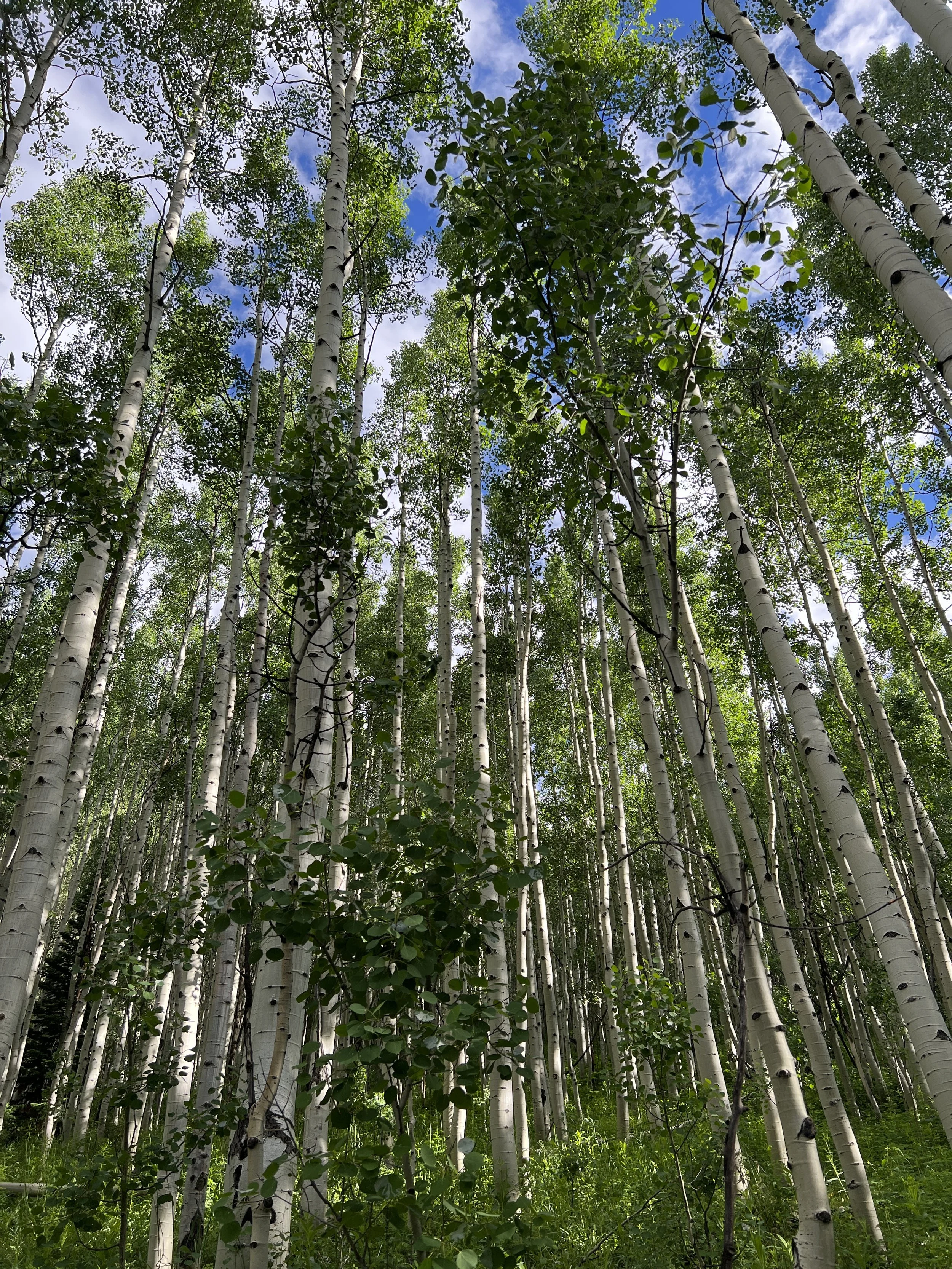The Bio-inspired Mindset: What Aspen Trees can Teach us About Cloning and Diversity
When I was a kid growing up in Colorado, aspen trees (Populus tremuloides) were a big part of playing outside. My friends and I made the leaves into whistles, rubbed the bark’s white powder on our faces as sunscreen, and lay under the trees to enjoy the beautiful sight of thousands of leaves “quaking” in even the lightest breeze.
I’m still enchanted by the shimmer of silver aspen leaves, especially when their summer green blazes into autumn gold.
💡 There’s magic going on underground as well: aspens can send out long lateral roots that sprout into a new tree that’s genetically identical to the parent tree. In other words, aspens can clone themselves.
The most famous aspen clone is the Pando clone in south-central Utah; “pando” is Latin for “I spread.” Pando is likely the world’s largest single organism by mass*, and it’s probably tens of thousands of years old. It covers an astonishing 43 hectares (that’s more than 100 acres to us Americans) and consists of about 47,000 genetically identical trees.
💡 That may sound like a very successful organism. But from an evolutionary perspective, a lack of genetic diversity often translates to fragility.
Sexual reproduction on Earth seems to have arisen for precisely this reason: the more diversity in a population, the more likely that some members of a population will survive if conditions change.
The Pando clone—or any other aspen clone—could be in a lot of trouble in the face of catastrophic and/or rapid changes in temperature, humidity, soil pH, pests, diseases, and other environmental factors. In contrast, a nearby aspen population (with a different root system) could harbor genetic variants missing from the first clone that would enable the second population’s members to survive the change.
This link between fragility and a species’ lack of genetic diversity isn’t special to aspens. Vast monocultures, such as iconic fields of corn stretching horizon to horizon, make industrial agriculture massively vulnerable to climate change. And at the ecosystem level, catastrophic declines in biodiversity at the species level threaten human livelihoods and survival.
Today, the Pando clone isn’t only vulnerable due to its genetics. Grazing deer and cattle have devastated young trees, enabled by a lack of predators and regulatory policies that allow grazing.
💡 Overall, aspen trees inspire us to reflect on the importance of diversity to individuals and to populations.
Although humans have caused climate change, urban/wild pressures, and other pressures to which genetically identical populations are vulnerable, we also have regulatory strategies, biotechnologies, and other convergent technologies that can help us to monitor the health of living things and to intervene before a crisis. Excitingly, tools like gene editing (e.g. CRISPR) may be useful to engineer genetic diversity and resilience back into species, including agricultural species, enhancing our food security. Biotech is even being used to resurrect species—like mammoths—that have played important roles in past ecosystems.
💡 Once again, with a bio-inspired mindset, we can see analogies to business and society. Just as genetic diversity is the fuel that drives evolution, diversity of people is creative fuel that drives innovation and revenue.
Over-optimization—of supply chains, of ways of doing business—can yield fragility just when robustness and resilience are most needed, as brutally illustrated by the COVID-19 pandemic.
In the biological world, diversity is a feature, not a bug. That is a powerful lesson for human endeavors as well!
*I recently overheard a guy in a bar telling his friends that he’d read that a kelp forest was now considered the world’s largest organism. I haven’t found supporting evidence for this in either the scientific literature or the lay press. But I loved chatting about biology with strangers in a bar!
About Tiffany
Dr. Tiffany Vora speaks, writes, and advises on how to harness technology to build the best possible future(s). She is an expert in biotech, health, & innovation.
For a full list of topics and collaboration opportunities, visit Tiffany’s Work Together webpage.
Get bio-inspiration and future-focused insights straight to your inbox by subscribing to her newsletter, Be Voracious. And be sure to follow Tiffany on LinkedIn, Instagram, Youtube, and X for conversations on building a better future.
Donate = Impact
After a 19-day voyage to Antarctica aboard The Island Sky in November 2023, Tiffany has many remarkable stories to share & a wealth of insights to catalyze a sustainable future.
You can support her ongoing journey by making a contribution through her donation page. Your support will spread positive impact around the world, empower Tiffany to protect time for impact-focused projects, and support logistical costs for pro bono events with students & nonprofits.
Disclosure: I am an affiliate of Bookshop.org where your purchases support local bookstores. I will earn a commission if you click through and make a purchase.


